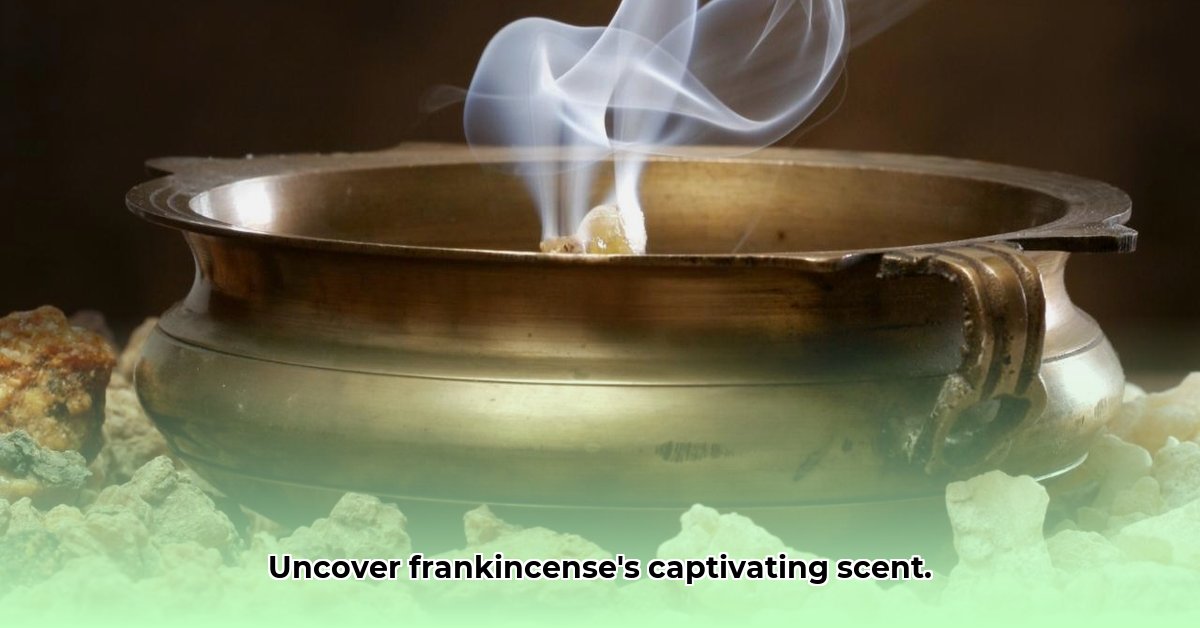Frankincense, a fragrance revered for centuries, has graced religious ceremonies and high-end perfumes alike. But what exactly defines its alluring scent? This comprehensive guide unveils the secrets behind frankincense’s aroma, comparing it to familiar scents and teaching you to identify the real deal. Prepare to delve into the captivating world of this remarkable resin, exploring its history, distinct olfactory profile, and unique characteristics.
Understanding the Complex Aroma of Frankincense
What does frankincense smell like? Its fragrance is a fascinating blend of aromatic notes. It’s a warm, comforting resinous base enhanced by hints of zesty citrus, a dash of warming spice, and even a surprising freshness reminiscent of pine and rosemary. This ever-shifting profile makes each experience unique, varying based on origin and processing methods.
Unpacking the Aromatic Mystery: A Symphony of Scents
Frankincense’s fragrance is not a singular note, but rather a symphony of scents:
- A warm, resinous embrace forms the grounding base, providing depth and longevity.
- Bright citrus notes, reminiscent of lemon or grapefruit, add an uplifting spark and zesty edge.
- Subtle spice accents offer warmth and complexity, reminiscent of cloves or cinnamon.
- A hint of fresh pine and rosemary contributes a clean, invigorating top note.
The beauty of frankincense lies in its ever-shifting nature; no two experiences are exactly alike. Each inhalation reveals a new facet of its aromatic complexity.
Factors Influencing Frankincense’s Scent Profile
Several factors contribute to the unique scent of Frankincense:
- Species: Different Boswellia species yield resins with distinct aroma profiles. Boswellia sacra, for example, is prized for its balanced fragrance, while Boswellia carterii offers a more intense, resinous scent.
- Origin: Frankincense from Oman often exhibits sweet and citrusy notes, while Somali varieties tend to be more intense and woody. Location plays a key role.
- Harvesting and Processing: Similar to winemaking, the harvesting and processing techniques significantly impact the final aroma. Careful drying and sorting are essential to preserving the resin’s delicate fragrance.
- Climate: Annual rainfall, temperature, and sunshine exposure influence the chemical makeup of the resin, ultimately shaping its scent.
A Sensory Adventure: Close Your Eyes and Imagine…
Imagine strolling through a bustling Arabian market, the sun warming your skin. The air is alive with the intoxicating aromas of exotic spices, fragrant resins, and freshly brewed coffee – that’s the essence of high-quality frankincense. Its warmth and comforting nature often evoke feelings of peace and serenity, similar to a quiet church filled with incense. Others liken it to the fresh, clean scent of a pine and rosemary forest after a refreshing rain shower, invigorating and grounding all at once.
Comparing Frankincense to Familiar Scents
To further clarify frankincense’s scent, consider these comparisons:
- Myrrh: While both are resins, myrrh presents a more bitter, earthy profile, while frankincense has more subtle sweetness qualities and a brighter overall character. Myrrh is often described as having a medicinal or smoky aroma, whereas frankincense is more uplifting.
- Pine: Frankincense shares woodiness and freshness with pine and rosemary, but lacks its sharp, pungent qualities. It is a soft scent with nuanced touch.
- Citrus: The citrus notes in frankincense are delicate whispers, offering a bright contrast to the richer, deeper woody base. It’s akin to a squeeze of lemon zest over a warm, earthy fragrance.
- Amber: While frankincense can belong to the amber fragrance family, its scent is less powdery and sweet than traditional amber. It possesses a more resinous and balsamic quality.
Frankincense in Action: How the Scent Transforms
Frankincense’s fragrance transforms depending on its application. In perfumes, it acts as a grounding base note, enhancing lighter floral or citrus scents. Aromatherapy utilizes its calming properties and helps create a space of tranquility when diffused. Burning frankincense resin releases a richer, more intense aroma than using diluted essential oil, filling the room with sacred notes.
Tips for Experiencing Frankincense’s Full Potential
To truly appreciate frankincense’s aroma, take your time and allow the scent to unfold gradually.
- Start Small: Begin with a small amount of resin or diluted essential oil to avoid overwhelming your senses.
- Control the Environment: Ensure the room is well-ventilated and free of other strong odors.
- Mindful Inhalation: Close your eyes and inhale deeply, paying attention to the different layers and nuances of the fragrance.
- Allow Time to Unfold: Give the scent time to develop and evolve on your skin or in the air.
- Experiment: Try different frankincense products (resin, essential oil, perfume) to experience its versatility.
Allow each layer to emerge and adapt the settings and mood.
The Final Word: A Fragrance to Discover
What does frankincense smell like? It’s a personal journey of the senses, a fragrant story that unfolds, surprising and delighting with its complexity and evolving character. Savor, explore, and appreciate its uniqueness – each encounter will be uniquely yours.
How to Identify Frankincense Scent Notes in Perfume Blends
Frankincense, with its complex aroma profile blending woody, earthy, and subtly spicy notes, often serves as a base or heart note in perfume blends. Understanding its scent characteristics enhances perfume appreciation and identification within various blends.
Key Takeaways:
- Frankincense offers a complex aroma profile, blending woody, earthy, and subtly spicy notes with hints of citrus, pine, and a touch of sweetness.
- Its scent varies depending on the Boswellia species, the environment where it is extracted, and the other ingredients it is paired with.
- Identifying frankincense requires careful sniffing combined with an understanding of fragrance layering and common frankincense pairings.
What Does Frankincense Smell Like and How to Decipher Scent
It encapsulates the warm, woody depths of a sun-drenched forest floor, a subtle spiciness reminiscent of cinnamon or cloves, a whisper of citrus, and a pine-like freshness. The scent of ancient temples, rich in history and mystery, captures the essence of frankincense. Its fragrance bridges the terrestrial and spiritual realms.
Deciphering Frankincense in a Blend: A Sensory Guide
Identifying frankincense in perfume blends requires familiarity with its pure scent. Here’s how to approach it:
- The Initial Impression: A gradual unveiling of woody and earthy notes suggests frankincense’s presence. It generally isn’t a top note, but it can contribute to the overall complexity of the opening.
- The Heart of the Fragrance: A warm, resinous aroma suggests the presence of frankincense in the heart notes. The scent should have impressive longevity and a slightly balsamic quality.
- The Dry Down: A subtle spiciness or pine-like aroma may emerge, pointing to frankincense. It often plays a supporting role, interacting with other base notes to create a long-lasting and memorable trail.
- The Overall Impression: Frankincense contributes to a fragrance’s depth, richness, and subtly mysterious allure. It adds a touch of sophistication and timeless elegance.
- Comparative Sniffing: Comparing the perfume’s scent to a pure frankincense oil can reveal similarities in the woody, earthy, and spicy facets. Understanding the different grades of frankincense essential oil help distinguish the scent.
Frankincense’s Role in Perfume Construction
Frankincense excels as a supporting player, enhancing other scents’ complexity and depth. As a base or heart note, it lends a grounding earthiness or mysterious warmth.
Common Blending Partners
Frankincense harmonizes beautifully with:
- Myrrh: Creates a classic, sacred scent reminiscent of ancient rituals.
- Citrus: Bright citrus cuts through frankincense’s richness, creating a vibrant and uplifting combination.
- Lavender: Creates a calming blend, perfect for promoting relaxation and reducing stress.
- Cedarwood: Magnificently pairs with deep woodiness, adding a touch of warmth and sophistication.
- Oud: Provides a luxurious, opulent combination, adding a touch of exoticism and mystery.
- Pepper: Adds a unique spicy edge, creating a stimulating and invigorating fragrance.
- Rose: Creates a beautiful balance to rich frankincense notes.
Frankincense in Religious Ceremonies: History and Significance
Frankincense, a resin with a distinctive aroma, holds immense religious and cultural importance across many civilizations. The sustainability of frankincense harvesting is a crucial consideration for its continued use.
Key Takeaways:
- Frankincense, a resin with a distinctive aroma, holds immense religious and cultural importance across many civilizations.
- Its use in religious ceremonies dates back millennia, with prominent roles in ancient practices and major world religions.
- Understanding its variations in scent and symbolic meaning across different cultures adds depth to its spiritual significance.
Delving into the Aromatic Profile
What does frankincense smell like? The answer, like the resin itself, is complex. It is a balsamic richness with a blend of warm pine needles, a whisper of myrrh, and a hint of lemony zest. Depending
- How Did Charles F. Brush Discover Wind Energy Tech? - November 19, 2025
- Wind Energy Vertical: Weighing the Pros and Cons of Wind Power - November 16, 2025
- How Much Energy Does a Wind Turbine Actually Create? - November 14, 2025
















